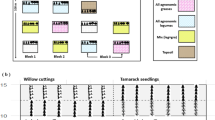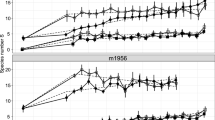Abstract
Facilitation (positive inter-specific interaction) plays an important role in promoting succession in harsh environments. To examine whether tussocks facilitate the establishment of other species, after peat mining, investigations were carried out in a formerly Sphagnum-dominated wetland (Sarobetsu mire, northern Japan). Two tussock-forming species, Carex middendorffii and Eriophorum vaginatum, have established in sparsely vegetated areas, with a dry ground surface, since peat extraction ended. The following factors were examined, in three microhabitats created by tussocks (center = raised tussock center, edge = tussock edge covered with litter, and flat = flat areas without tussocks): (1) relationships between tussock microhabitats and plant distributions, and (2) the effects of tussocks on survival, growth, flowering and seed immigration of common species. Two (1 × 10 m) plots were established, in each of three sparsely vegetated sites, in September 2005. Tussocks were mapped in each plot, and species, location, flowering, growth stage (seedling, juvenile and fertile) and size of all plants were recorded, during snow-free periods from September 2005 to September 2006. Seed traps were used to investigate seed dispersal from June to October 2006. Four native species, Drosera rotundifolia, Lobelia sessilifolia, Moliniopsis japonica, Solidago virgaurea, and an exotic species, Hypochaeris radicata, were most common. During seedling and juvenile stages, these species were distributed more densely at the tussock edge than in the flat areas, but were less common at the center. H. radicata had a higher survival rate at the edge than in the flat during the winter. The annual growth of H. radicata, L. sessilifolia and S. virgaurea was higher at the edge. Seed traps detected that D. rotundifolia seeds accumulate more at the edge. In conclusion, tussocks facilitated plant establishment in the edge microhabitat by providing litter cover, enhancing seed accumulation, germination and survival, and thus promoted revegetation. However, Sphagnum mosses have not established in the study sites, and the vegetation differs strongly from the areas where no peat mining had taken place.



Similar content being viewed by others
References
Badano EI, Villarroel E, Bustamante RO, Marquet PA, Cavieres LA (2007) Ecosystem engineering facilitates invasions by exotic plants in high-Andean ecosystems. J Ecol 95:682–688
Bergelson J (1990) Life after death: site pre-emption by the remains of Poa annua. Ecology 71:2157–2165
Bertness MD, Callaway R (1994) Positive interactions in communities. Trends Ecol Evol 9:191–193
Bosy JL, Reader RJ (1995) Mechanisms underlying the suppression of forb seedling emergence by grass (Poa pratensis) litter. Funct Ecol 9:635–639
Bruno JF (2000) Facilitation of cobble beach plant communities through habitat modification by Spartina alterniflora. Ecology 81:1179–1192
Burnham KP, Anderson (2002) Model selection and multimodel inference: a practical information-theoretic approach, 2nd edn. Springer, New York
Callaway RM, Walker LR (1997) Competition and facilitation: a synthetic approach to interactions in plant communities. Ecology 78:1958–1965
Campbell DR, Rochefort L (2003) Germination and seedling growth of bog plants in relation to the recolonization of milled peatlands. Plant Ecol 169:71–84
Campbell DR, Lavoie C, Rochefort L (2002) Wind erosion and surface stability in abandoned milled peatlands. Can J Soil Sci 82:85–95
Cavieres LA, Quiroz CL, Molina-Montenegro MA (2008) Facilitation of the non-native Taraxacum officinale by native nurse cushion species in the high Andes of central Chile: are there differences between nurses? Funct Ecol 22:148–156
Chabrerie O, Alard D (2005) Comparison of three seed trap types in a chalk grassland: toward a standardised protocol. Plant Ecol 176:101–112
Chapin FS, Walker LR, Fastie CL, Sharman LC (1994) Mechanisms of primary succession following deglaciation at Glacier Bay, Alaska. Ecol Monogr 64:149–175
Crain CM, Bertness MD (2005) Community impacts of a tussock sedge: is ecosystem engineering important in benign habitats? Ecology 86:2695–2704
Crooks JA (2002) Characterizing ecosystem-level consequences of biological invasions: the role of ecosystem engineers. Oikos 97:153–166
Crowder AA, Pearson MC, Grubb PJ, Langlois PH (1990) Drosera L. J Ecol 78:233–267
Eckstein RL, Donath TW (2005) Interactions between litter and water availability affect seedling emergence in four familial pairs of floodplain species. J Ecol 93:807–816
Egawa C, Koyama A, Tsuyuzaki S (2009) Relationships between the developments of seedbank, standing vegetation and litter in a post-mined peatland. Plant Ecol 203:217–228. doi:10.1007/s11258-008-9536-5
Egerova J, Proffitt CE, Travis SE (2003) Facilitation of survival and growth of Baccharis halimifolia L. by Spartina alterniflora Loisel. in a created Louisiana salt marsh. Wetlands 23:250–256
Ervin GN (2005) Spatio-temporally variable effects of a dominant macrophyte on vascular plant neighbors. Wetlands 25:317–325
Ervin GN, Wetzel RG (2002) Influence of a dominant macrophyte, Juncus effusus, on wetland plant species richness, diversity, and community composition. Oecologia 130:626–636
Facelli JM, Pickett STA (1991) Plant litter: light interception and effects on an old-field plant community. Ecology 72:1024–1031
Fogel BN, Crain CM, Bertness MD (2004) Community level engineering effects of Triglochin maritima (seaside arrowgrass) in a salt marsh in northern New England, USA. J Ecol 92:589–597
Groeneveld EVG, Rochefort L (2005) Polytrichum strictum as a solution to frost heaving in disturbed ecosystems: a case study with milled peatlands. Restor Ecol 13:74–82
Hotes S, Poschlod P, Takahashi H (2006) Effects of volcanic activity on mire development: case studies from Hokkaido, northern Japan. Holocene 16:561–573
Jefferson RG, Usher MB (1989) Seed rain dynamics in disused chalk quarries in the Yorkshire-Wolds, England, with special reference to nature conservation. Biol Conserv 47:123–136
Lavoie C, Marcoux K, Saint-Louis A, Price JS (2005) The dynamics of a cotton-grass (Eriophorum vaginatum L.) cover expansion in a vacuum-mined peatland, southern Quebec, Canada. Wetlands 25:64–75
Levine JM (2000) Complex interactions in a streamside plant community. Ecology 81:3431–3444
Morris WF, Wood DM (1989) The role of Lupine in succession on Mount St. Helens: facilitation or inhibition? Ecology 70:697–703
Nishimura A, Tsuyuzaki S, Haraguchi A (2009) A choronosequence approach for detecting revegetation patterns after Sphagnum-peat mining, northern Japan. Ecol Res 24:237–246
Paquet JM, Caron J, Banton O (1993) In situ determination of the water desorption characteristics of peat substrates. Can J Soil Sci 73:329–339
Peach M, Zedler JB (2006) How tussocks structure sedge meadow vegetation. Wetlands 26:322–335
Pellerin S, Lavoie C (2000) Peatland fragments of southern Quebec: recent evolution of their vegetation structure. Can J Bot 78:255–265
Price J (1997) Soil moisture, water tension, and water table relationships in a managed cutover bog. J Hydrol 202:21–32
R Development Core Team (2007) R: a language and environment for statistical computing. R Foundation for Statistical Computing, Vienna
Rousset O, Lepart J (2000) Positive and negative interactions at different life stages of a colonizing species (Quercus humilis). J Ecol 88:401–412
SDMO (Sapporo District Meteorological Observatory) (2006) http://www.sapporo-jma. go.jp/Cited 28 May 2008
Soons MB (2006) Wind dispersal in freshwater wetlands: knowledge for conservation and restoration. Appl Veg Sci 9:271–278
Soons MB, Heil GW (2002) Reduced colonization capacity in fragmented populations of wind-dispersed grassland forbs. J Ecol 90:1033–1043
Taylor K, Rowland AP, Jones HE (2001) Molinia caerulea (L.) Moench. J Ecol 89:126–144
Tsuyuzaki S, Tsujii T (1992) Size and shape of Carex meyeriana tussocks in an alpine wetland, northern Sichuan Province, China. Can J Bot 70:2310–2312
Tuittila ES, Rita H, Vasander H, Laine J (2000) Vegetation patterns around Eriophorum vaginatum L. tussocks in a cut-away peatland in southern Finland. Can J Bot 78:47–58
Walker LR, Clarkson BD, Silvester WB, Clarkson BR (2003) Colonization dynamics and facilitative impacts of a nitrogen-fixing shrub in primary succession. J Veg Sci 14:277–290
Xiong SJ, Nilsson C (1999) The effects of plant litter on vegetation: a meta-analysis. J Ecol 87:984–994
Yamada M, Takahashi H (2004) Frost damage to Hemerocallis esculenta in a mire: relationship between flower bud height and air temperature profile during calm, clear nights. Can J Bot 82:409–419
Acknowledgments
We are grateful to Titus JH and Ward R for their critical readings of the manuscript. We thank Kubo T for statistical analysis, Akasaka M and Ida TY for advice, and Nishimura A and Egawa C for support in field survey. We also thank all members in the laboratory of Regional Ecosystems, GSEES, Hokkaido University. Cordial thanks are also due to the staff members of the Ministry of Environment of Japan and Toyotomi Town Office for permission and support to carry out this study. This works is partly supported by Japan Society for the Promotion of Science.
Author information
Authors and Affiliations
Corresponding author
Rights and permissions
About this article
Cite this article
Koyama, A., Tsuyuzaki, S. Effects of sedge and cottongrass tussocks on plant establishment patterns in a post-mined peatland, northern Japan. Wetlands Ecol Manage 18, 135–148 (2010). https://doi.org/10.1007/s11273-009-9154-6
Received:
Accepted:
Published:
Issue Date:
DOI: https://doi.org/10.1007/s11273-009-9154-6




